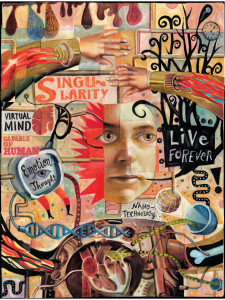 Imagine a sealed box, tightly closed away from any possible connection; now picture a heart in the center, away from any human interaction. According to Brené Brown, author of Daring Greatly and new book, Rising Strong, said when people fail once or fear the possibility of connection, they hold themselves back. Brown said the so-called imperfections and experiences block people from life’s purpose.
Imagine a sealed box, tightly closed away from any possible connection; now picture a heart in the center, away from any human interaction. According to Brené Brown, author of Daring Greatly and new book, Rising Strong, said when people fail once or fear the possibility of connection, they hold themselves back. Brown said the so-called imperfections and experiences block people from life’s purpose.
“Connection is why we’re here; it is what gives purpose and meaning to our lives. The power that connection holds power in our lives was confirmed when the main concern about connection emerged from the fear of disconnection; the fear that something we have done or failed to do, something about who we are or where we come from has made us unlovable and unworthy of connection,” Brown said.
As people begin to experience more, their emotions grow and evolve based on their understanding of connection and worthiness, according to Brown. These emotions not only create thoughts, but also establish standards for behaviors.
“The self-conscious emotions are powerful motivators of human behavior,” Michael Lewis, author of Handbook of Emotions, said.
Emotions are strongly dependent on our environment and culture, according to Lewis. How people develop from children to adults sets personal standards with how they express themselves. Brown said, unlike adults, children have strong spirits—life is still sparkling with curiosity; they don’t mask the negativity. They feel the emotions and then move on with creating new experiences. As adults, the moment we feel uncertainty, fear, or shame, we shut down, according to Brown.
“Vulnerability is not weakness, and the uncertainty, risk and emotional exposure we face every day are not optional,” Brown said. “Our only choice is a question of engagement. Our willingness to own and engage with our vulnerability determines the depth of our courage and the clarity of our purpose; the level to which we protect ourselves from being vulnerable is a measure of our fear and disconnection.”
Along with the creation of self-conscious emotions, behavioral acts also have a role in the blockage of painful emotions. Robert Plutchik, psychologist and professor at The Albert Einstein College of Medicine said verbal reports of emotion influence behaviorism. Emotions may be repressed, inhibited or conscious, according to Plutchik. Language itself is ambiguous; this results in people not knowing the differences between fear and anxiety, guilt and shame, or envy and jealousy.
As a result of repressing feelings, physical behavior changes. This means feelings are connected through events and situations that motivate actions. Emotions generally have an underlying cause that trigger physiological awareness. This means not only are emotions culturally scripted, they are also personally manipulated. Even though actions show emotions, the brain is the controller. The structure of our brain has the ability to influence thoughts from our conscious and unconscious mind.
Larry Cahill, neuroscientist, said emotions are stimulated by concealed memories. People’s behaviors are guided by the interaction of the brain and the body. Cahill said the cause of emotional impulses have to do with the prefrontal cortex, which sets emotional tone. These differences and brain impulses are the root of self-concept.
According to Brown, people start to self-regulate emotions and conform to society’s rule of emotional display. She said before people realize, they have already started building a wall around their hearts because they feel unaccepted, blamed for their emotional state, or guilty because they feel unworthy.
“I believe that owning our worthiness is the act of acknowledging that we are sacred. Perhaps embracing vulnerability and overcoming numbing is ultimately about the care and feeding of our spirits,” Brown said.
Starting at a young age, humans are taught to control themselves. Brown said that people must feel worthy in order to embrace love. This corresponds with the masking of negative emotions. If people do not feel as though they deserve love and connection, then in result they will hide from interaction, Brown said. Many of our painful memories consist of fear, shame, and guilt. This is when shame takes control—the feeling of not being good enough, the feeling of no one caring, the feeling of suffering, according to Brown.
“We live in a world where most people still subscribe to the belief that shame is a good tool for keeping people in line. Not only is this wrong, but it’s dangerous,” Brown said. “Shame is highly correlated with addiction, violence, aggression, depression, eating disorders, and bullying.”
Certain regions of the brain consist of pain, conflict, isolation, memory, attention, decision-making, and emotional display. The amygdalae manage our sense of fear and the dorsal anterior cingulate cortex recognizes anger. However, sadness involves more than 70 regions in the brain. Many negative emotional states consist of one section of the brain, but triggers physical behavior. Similar to sadness, love and happiness consist of many regions of the brain. Sometimes because sadness and love can overpower one another, the results can be blinding. The amygdala can block out the ability to love because the sadness region is exceeding its power. This uncertainty has a way of shutting us down, according to Brown.
“Worrying about scarcity is our culture’s version of post-traumatic stress. It happens when we’ve been through too much, and rather than coming together to heal (which requires vulnerability) we’re angry and scared and at each other’s throats,” Brown said.
Even though humans are capable of hiding pain, it doesn’t mean they have an absence of happiness. Positive emotions are processed on the left hemisphere of cerebral cortex, and negative emotions are on the right hemisphere. This explains why people are able to feel happy and sad at the same time. Patterns of emotional communication relate to self-development. When unconscious emotions and memories are stored, people unconsciously activate the subcortical cortex of the brain, according to Cahill. This results in feelings either displayed or hidden unconsciously.
In order to produce more positive emotions to break the barrier, people should change the direction of the original interaction. Humans should set a standard that consists of the power of love, while trusting uncertainty, according to Brown. She said vulnerability “sounds like trust and feels like courage,” and is a necessity in order to live life to the fullest.
“Vulnerability is not knowing victory or defeat—it’s understanding the necessity of both; it’s engaging. It’s being all in,” Brown said.
Gabrielle Sharp
Executive Editor
